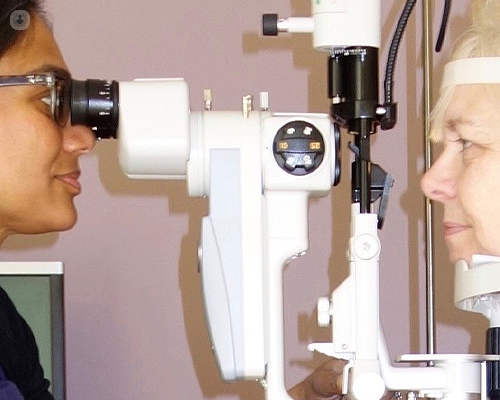An expert’s guide to cataracts: signs, symptoms and surgery
Autore:Cataracts are undoubtedly debilitating but thankfully curable. Despite knowing this, patients might want to discover more detail behind the condition such as the signs, symptoms and what’s involved in cataract surgery.
Esteemed consultant ophthalmic surgeon Ms Nishani Amerasinghe has created a comprehensive guide to cataracts, answering any questions Top Doctors readers may have.

What are the causes and symptoms of cataracts?
The main cause of cataracts is age. When you are younger the lens of the eye is clear, allowing light into the eye and allowing us to see. As we get older the lens becomes opaquer, limiting our vision.
The natural lens in the eye acts like a camera lens focusing light onto the retina. As we age, the lens, which is made up of water and protein, becomes cloudier. This is because the proteins clump together. This causes the reduction in the clarity of the vision.
Other causes include medical conditions like:
- Diabetes
- Long term use of steroids
- Injury to the eye
- Smoking
- Drinking too much alcohol
- Previous eye surgery
- Ultraviolet light radiation
- A family history of cataracts
Early cataracts may not affect your vision, however. As it develops, it can result in a gradual, painless blurring of vision, like looking through frosted glass. Certain types of cataract splits light rays causing certain lights (like the sun or a lamp) to seem too bright or glaring. They can cause dazzle or glare with car headlights, too. This symptom can be quite debilitating and can stop people driving, especially at night.
Sometimes, when a certain type of cataract known as a nuclear cataract develops, a patient can have temporary improvement in their near vision. This is known as second sight. However, this does not last long and disappears when the cataract worsens.
Other symptoms include needing a brighter light to read, fading or yellowing of colours and double vision in one eye.
Can cataracts occur at any age?
In most cases, cataracts are age related. They first appear when a patient is their 40, 50s. They may not go on to affect vision until the patient is over 60 or even later.
However, some babies are born with cataracts (congenital cataracts). Children can also develop cataracts; these are known as developmental, infantile or juvenile cataracts. This is a rare occurrence.
Cataracts can also develop in patients’ 20s or 30s. This is due a variety of causes, including:
- Injury
- Diseases like:
- Diabetes
- Radiation
- Steroids
- Smoking
- Eye surgery
Are there consequences if people leave cataracts untreated?
Cataracts usually form very slowly so the symptoms are gradual. However, this is not always the case. If left untreated, the visual symptoms will worsen and the cataract will debilitate to a point where vision is seriously impaired.
Can you describe the cataract removal procedure and recovery process?
Cataract surgery is a day-case procedure; a patient will not be required to stay overnight. The procedure itself does not take very long, about 15 minutes, however the patient will be in the hospital for a few hours. This will allow time for the dilating drops to work as well as the anaesthetic.
The surgery is usually carried out under local anaesthetic and this usually in the form of eye drops. However, if a patient is overly anxious, an anaesthetist can administer sedation.
Cataract surgery involves the cloudy, cataractous natural lens being removed and being replaced by an intraocular lens. The cataract is removed by phacoemulsification. This process involves an ultrasound probe being inserted into the eye via a small incision. The surgeon makes this incision and a hole in the capsular bag that holds the cataract. High frequency ultrasound then breaks up the lens into small pieces, which are aspirated (removal technique) and removed. The new intraocular lens is then placed in the natural capsular bag in the place of the cataract.
An antibiotic is then placed in the eye and the surgical incisions are closed. This does not usually require any stitches. A clear shield is placed over the eye to protect it initially from anything getting in.
After the surgery, patients need to apply eye drops for four weeks after surgery. Vision usually starts improving within 48 hours of surgery.
It’s advised that care is taken when washing hair and face for the first two weeks after the surgery. No eye make-up should be worn for two weeks and strenuous exercise should be avoided for the same amount of time. Any eye medications for other ocular conditions are usually continued on the advice of the surgeon. This will ensure the best chance of a good outcome after surgery.
Can patients do anything to reduce risk of developing cataracts?
Currently there is no proven ways to prevent cataracts. However, maintaining good eye health enables cataracts to be detected and may reduce the risk their development.
Regular eye examinations at the optician help detect cataracts and other eye problems at their earliest stages.
Smokers have a higher risk of cataract surgery compared to non-smokers. Over time, quitting smoking can reduce that risk.
Diabetes is associated with a higher risk of cataracts and the condition should be well managed because of this.
Studies haven’t proven that antioxidants in a pill prevent cataracts. However, a large population study has shown that a healthy diet which includes lots of vitamins and minerals was associated with a reduced risk of cataract development.
The sunshine’s ultraviolet rays increase the risk of cataracts so wearing UV protectant sunglasses will help reduce the risk.
Excessive alcohol intake also increases the risk of cataracts. Therefore, reducing intake will reduce the risks.
If you suspect you may have cataracts or require surgery, Ms Amerasinghe can provide expert help. Visit her Top Doctors profile here in order to arrange an appointment.



